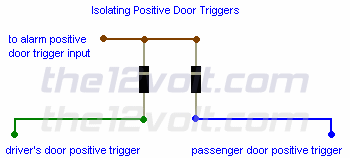I drive a 2006 Chevrolet Equinox and it's disappointing that it doesn't have any floor illumination. So I'd like to add some. I'll preface this by saying that I am pretty experienced with wiring and circuits.
My goal for the project is to add LEDs beneath the seats to illuminate the floor whenever one of the following conditions is met:
1) When the dome lights are on.
2) At night when my automatic headlights come on (license plate lamps)
3) When I activate one of the Ext Switches on my DNX9140 Nav.
I know how to hook up the DNX9140 and the automatic headlight trigger using a relay. However, my dome lights are stumping me. When they turn off, they fade. I believe the ground fades (see pictures below). If I simply use a relay for the dome lights, the relay will probably switch on and off rapidly while the dome lights fade. I'd like to avoid this. After reading a bit online, I figured using a transistor as an amplifier may be the solution. I don't know too much about transistors and the fact that the ground fades has me stumped even more. I will use a capacitor will make the lights fade.
Here are some pictures. The first is the circuit I drew up. The second and third are schematics and descriptions from AllData for my interior lighting.
Click them for bigger images.



Please help! I need someone to either confirm that my circuit will work, and if so recommend what transistor to use. And what value resistor to use for the transistor.
Or fix it all together and help me make a circuit that will work.
Thanks a lot guys!
The simplest might be to insert a diode between the door switch and the rest of the circuitry, and hot relay that is grounded thru another diode (and connected below the inserted diode) thru the door switch. That assumes it can turn off as soon as the door switch opens (ie, the door closes).
The circuit you drew won't work - eg: LEDs won't work thru a cap. And that relay will also gradually turn off.
I assume the dimming is in the +12V side of the lamps (not GND) - both from the description and the schematic....
And that the BCM is not PWM (as required for LEDs etc but not incandescents).
The relay won't pulse as much as turn off when the voltage decreases enough, though some chattering may occur at that point.
that sounds like a much simpler solution.
few more questions. i don't know much about diodes. i did read the https://www.the12volt.com/diodes/diodes.asp page though. still a little hazy.
1) Would I hook up the diode to the ground side of the door latch? Or the positive voltage side?
2) What do I hook the other side of the diode to? The trigger input of the relay?
sorry if this is supposed to be common sense. I'm still slowly learning.
The switch side...
IE - you want the door's grounding switch to turn on your
new relay and still turn on your normal lights/dimmer.
But instead of connecting the together (new rely to old circuit), you need to insert "blocking" diodes to keep the 2 circuit isolated.
See f.ex
the12volt/diodes.asp.
EG - you would use

...where the Kathode = line-end "
to alarm positive door trigger input" is to your door switch (ie Courtesy Lamps Switch, or Door Ajar Switches if appropriate)...
..and the other ends are: one to the normal car circuit, and one to #85 of the relay (#86 being to +12V).
Keep in mind current in a diode can flow from Anode to Cathode = Anode "in the direction of the arrow" and out the Cathode where the Cathode is the line end (aka brick wall end - current hits the wall if it comes in that end).
The arrow refers to the circuit symbol --->|--- ie, A-->|--K where we use K for Kathode because it's the mirror image diode symbol to above - ie, K--K--A.
Apologies - I thought I had a good
door-switch and other stuff via diodes diagram in another thread, but I can't find it....
[ FYI - The above is not the reason for the K=Cathode, but it's the reason I'm giving because I find it easy to remember the "arrow" symbol, hence I can work out the direction of current flow +ve to -ve in the direction of the arrow.
The rest is easy....
Viz: the line end of the K or arrow --|<-- is the line end of the actual diode.
And if the line-end is is the K end, the other end must be the Anode.
And since it is +ve to -ve thru the arrow - ie, +ve into Anode & -ve at the K/Cathode, I sound as if I know something despite the fact that I never really remember whether anodes are +ve or -ve.
That's what I call "from first principles" (which is how people like me with limited memory work or survive!).
]that would make the LEDs come on when the doors open and close. But i'd like to have them on whenever the dome light comes on. like when i hit unlock on my key fob or manually turn on the dome light. how would i do that?
Well, if the door switches control when the dome comes on....
Then you have to add the other triggers whatever they are... lock/unlock signal etc...; latching or timers, thru dimmer or not...



